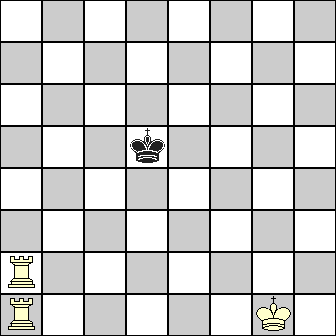In Endgame tactics Part 1 of this two part article, we discussed the chess tactics for checkmate with the ‘heavy’ pieces viz., Queen, Rook or a combination of those pieces. Now we will consider the more difficult tasks of creating checkmate with a Bishop pair or a Bishop and Knight.
6. When you have a Bishop pair

1. Kf2 Ke5
2. Kf3 Kd5
3. Bc3 Kc5
4. Ke4 Kd6
5. Bc4 Kc6
6. Bd4 Kd6
7. Bd5 Kc7
8. Bc5 Kd7
9. Ke5 Kc7
10.Ke6 Kd8
11.Bb6+ Ke8
12.Bc6+ Kf8
13.Kf6 Kg8
14.Bc5 Kh7
15.Bf8 Kg8
16.Bg7 Kh7
17.Be4+ Kg8
18.Bh6 Kh8
19.Kg6 Kg8
20.Bd5+ Kh8
21.Bg7#
You should note that a wrong step could lead to stalemate and draw.
The point you should realize is that the two bishops side by side on a row or file create a double V forcing the enemy King to remain within the wedge-shaped area. The bishops moves should push the V towards the edge to force the Black King to move there. While repositioning Bishops, your own King has to guard against the Black King escaping out of the wedge.
7. When you have a Bishop and Knight
A Bishop and Knight can be used to deliver the checkmate only when the Black King can be pushed into a corner square that is accessible to your Bishop. So, if you have KB (which controls white squares), black King has to be driven to a8 or h1 squares. If it is QB, checkmate will be possible when the black King is in a1 or h8 square. Your game plan has to take this into consideration, otherwise you will be wasting moves.
Depending on the final position reached, the checkmate may be by a Bishop check or a Knight check.
Assuming that your KB is on board, the white squares will be guarded by the Bishop and the black squares by the Knight (or Knight in tandem with King).
Black’s tactics in the above situation will be to avoid going towards a8 or h1 square, so White should guard against this plan of Black.

1. Kf2 Kd4 21.Bd3 Kf2
2. Nf3+ Kd5 22.Bc4 Kg2
3. Ke3 Ke6 23.Ne5 Kh3
4. Ke4 Kf6 24.Ng6 Kg2
5. Bc4 Kg7 25.Ke3 Kg3
6. Kf5 Kh8 26.Be6 Kh2
7. Ng5 Kg7 27.Kf3 Kg1
8. Ne6+ Kh6 28.Bh3 Kh2
9. Kf6 Kh7 29.Nf4 Kg1
10.Bd3+ Kh6 30.Bg2 Kh2
11.Ng5 Kh5 31.Nh5 Kg1
12.Nf7 Kg4 32.Ng3 Kh2
13.Ke5 Kh5 33.Bf1 Kg1
14.Bf5 Kh4 34.Bg2 Kh2
15.Kf4 Kh5 35.Nf1+ Kg1
16.Be4 Kh4 36.Bh3 Kh1
17.Bg6 Kh3 37.Kg3 Kg1
18.Ng5+ Kh4 38.Nd2 Kh1
19.Nf3+ Kh3 39.Bg2+ Kg1
20.Bf5+ Kg2 40.Nf3#
There are more than half a dozen ways in which the final check would be possible through the Knight or the Bishop. If you understand the general principle of the tactics, you can find your way to win.
The best way to get familiar with the tactics is to play with your chess-playing friend from a set-up position, telling him the tactics you are going to adopt and your friend should try his best to delay the checkmate. Keep a count and record of the moves and see how quickly you can reach your target. With practice, these types of tactics will soon become a part of your arsenal.






